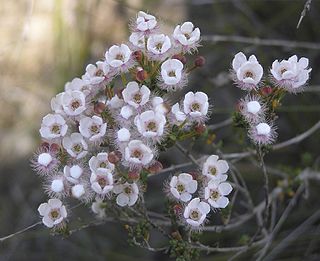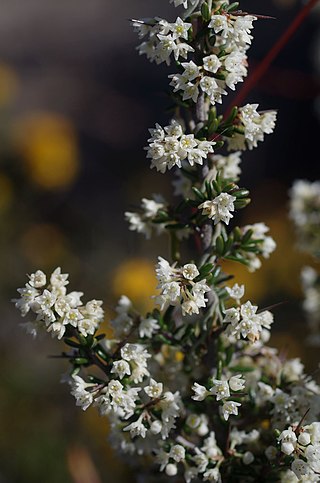
Calectasia is a genus of about fifteen species of flowering plants in the family Dasypogonaceae and is endemic to south-western Australia. Plants is this genus are small, erect shrubs with branched stems covered by leaf sheaths. The flowers are star-shaped, lilac-blue to purple and arranged singly on the ends of short branchlets.

Verticordia habrantha, commonly known as hidden featherflower, is a flowering plant in the myrtle family, Myrtaceae and is endemic to the south-west of Western Australia. It is a slender shrub with short, leafy side-branches and long flowering stems with rounded heads of mostly white flowers. Its hairy sepals are mostly hidden by the round, unfringed petals, and as a result, the plant looks like shrubs in the genus Chamelaucium, to which it is closely related.
Anigozanthos preissii, the Albany cat's paw, is a herbaceous plant species in the family Haemodoraceae, endemic to Western Australia.

Wurmbea monantha is a perennial herb that is native to Western Australia. The white to pink flowers are produced between July and September in its native range.

Calectasia intermedia, commonly known as blue tinsel-lily or eastern tinsel lily is a species of flowering plant in the family Dasypogonaceae, endemic to the border areas of western Victoria and south-eastern South Australia and flowering in early spring. It is the only member of the genus Calectasia that is not endemic to Western Australia.

Calectasia cyanea, commonly known as the star of Bethlehem or blue tinsel lily, is a plant in the family Dasypogonaceae growing as a perennial herb and is endemic to the south–west of Western Australia. Restricted to a single population in Torndirrup National Park, it is critically endangered.
Calectasia browneana, commonly known as blue tinsel lily, is a plant in the family Dasypogonaceae growing as a spreading, perennial, tufted herb. It is an uncommon species, endemic and restricted to a few areas in the south-west of Western Australia. It is similar to the other species of Calectasia and has only been recognised as a separate species since a review of the genus in 2001. It is distinguished from the others mainly by the hairiness of its leaves and lack of a rhizome.

Calectasia gracilis, commonly known as blue tinsel lily, is a plant in the family Dasypogonaceae and is endemic to the south-west of Western Australia. It is a spreading, tufted, woody, perennial herb with blue petals and six yellow stamens that turn orange-red as they age. It is similar to the other species of Calectasia and has only been recognised as a separate species since a review of the genus in 2001.

Calectasia hispida, commonly known as blue tinsel lily or hispid tinsel lily, is a plant in the family Dasypogonaceae growing as a rhizomatous, erect, clumping perennial herb. It is endemic to the south-west of Western Australia and is common in most of its range. It is similar to the other species of Calectasia and is distinguished from them mainly by the hairiness of its leaves and the glabrousness of the throat of the flowers.
Calectasia keigheryi, commonly known as blue tinsel lily, is a plant in the family Dasypogonaceae growing as an erect, rhizomatous, perennial herb. It is an uncommon species, endemic and restricted to a few areas in the south-west of Western Australia. It is similar to the other species of Calectasia and has only been recognised as a separate species since a review of the genus in 2001. It is relatively easily distinguished from the others mainly by its smaller flowers, unusual anther shape, and hairs on the lower part of the petals.

Calectasia narragara, commonly known as a blue tinsel lily or star of Bethlehem, is a plant in the family Dasypogonaceae growing as a tufted rhizomatous herb. It is endemic to the southwest of Western Australia and common in most of its range.
Calectasia pignattiana, commonly known as the stilted tinsel lily or Pignatti's star of Bethlehem, is a plant in the family Dasypogonaceae growing as a perennial herb and is endemic to the south–west of Western Australia. It is only known from ten locations, four of which are on road verges. The species is classified as vulnerable.

Calectasia obtusa, commonly known as a blue tinsel lily or blunt-leaved tinsel lily is a plant in the family Dasypogonaceae growing as an erect, small shrub with stems to 50 cm. It is endemic to the south-west of Western Australia, widespread in most of its range but only known from nine populations.
Calectasia palustris, commonly known as a blue tinsel lily or swamp tinsel lily is a plant in the family Dasypogonaceae growing as a perennial, tufted herb with stilt roots. It is an uncommon species, endemic and restricted to a few areas in the south-west of Western Australia. It is similar to the other species of Calectasia and has only been recognised as a separate species since a review of the genus in 2001.

Seringia integrifolia, commonly known as common firebush, is a species of flowering plant in the family Malvaceae and endemic to the south-west of Western Australia. It is a compact shrub, its new growth densely covered with star-shaped hairs, and has mostly narrowly leaves and many deep blue to purple flowers arranged in groups of 4 to 10.
Platysace cirrosa, commonly known as karna, is a twining, perennial herb or climber that is endemic to the south-west of Western Australia. The Noongar name for the plant is kanna. It is leafless, sometimes with a few very small scale-like leaves, and flowers arranged in umbels with overlapping yellow petals and flattened fruit.

Xanthorrhoea gracilis, commonly known as the graceful grasstree, grassboy or mimidi, is a species of grasstree of the genus Xanthorrhoea native to Western Australia.

Tribonanthes violacea belongs to the genus Tribonanthes in the bloodwort family, Haemodoraceae. It was first described by Stephan Endlicher in 1846. It is a perennial herb growing from 0.05 to 0.2 m high, in peat, white, grey or yellow sands, clay loams and granite in areas which are seasonally wet and on granite outcrops. Its white to purple flowers are seen from July to October.

Cryptandra pungens is a species of flowering plant in the family Rhamnaceae and is endemic to the southwest of Western Australia. It is an erect, slender, spiny shrub that typically grows to a height of 0.2–1 m with many short branches ending with thin spines. Its leaves mostly in bundles and are 4–6 mm (0.16–0.24 in) long. The flowers are white, each on a pedicel 1–2 mm (0.039–0.079 in) long with minute, overlapping brown bracts at the base. The sepals are about 1.6 mm (0.063 in) long and joined at the base to form a broadly bell-shaped tube, with lobes half as long as the tube. Flowering occurs from May to November. The species was first formally described in 1845 by Ernst Gottlieb von Steudel in Lehmann's Plantae Preissianae from specimens collected in sandy forest near Perth. The specific epithet (pungens) means "ending in a sharp, hard point".

Platysace filiformis is a species of flowering plant in the family Apiaceae and is endemic to the south-west of Western Australia. It is an erect or sprawling, perennial herb or shrub with flat, winged stems with few leaves and white or cream-coloured flowers arranged in compound umbels.














